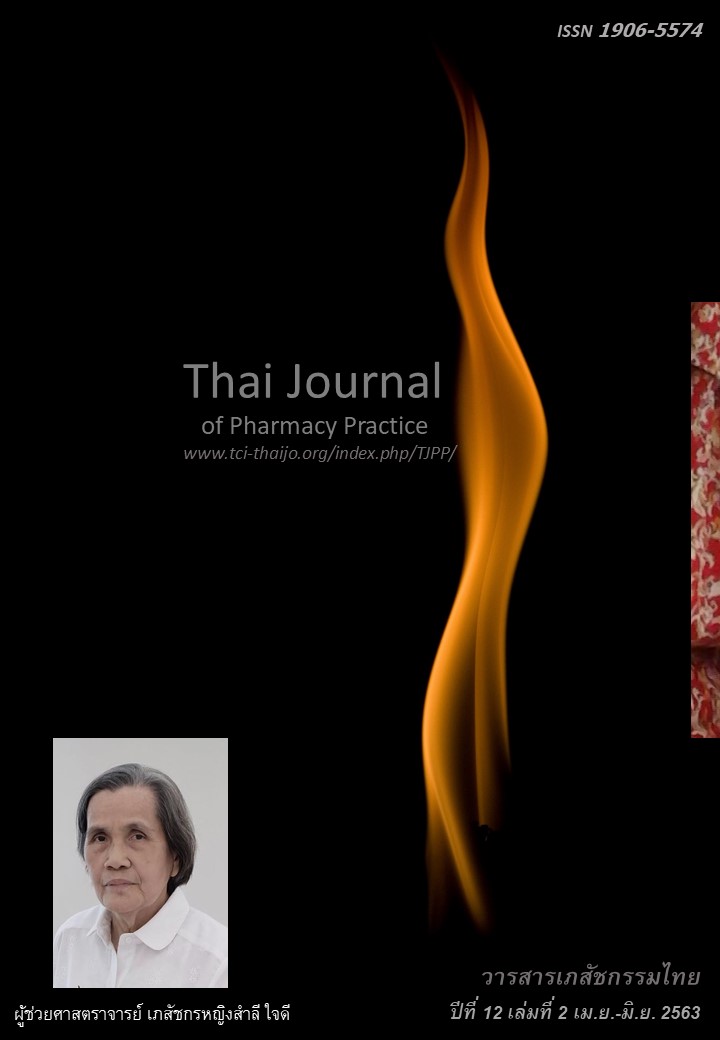การพัฒนาและประเมินผลของฉลากภาพ “คำแนะนำการใช้ยา” สำหรับผู้ป่วยชาวไทยมุสลิมที่ไม่รู้หนังสือ
Main Article Content
บทคัดย่อ
วัตถุประสงค์: เพื่อพัฒนาและทดสอบการสื่อความหมายของฉลากภาพ “คำแนะนำการใช้ยา” ในผู้ป่วยชาวไทยมุสลิมที่ไม่รู้หนังสือ วิธีการ: ผู้วิจัยสำรวจคำแนะนำการใช้ยาในฉลากช่วยของโรงพยาบาลยะลาจากใบสั่งยา 52,929 ใบในช่วงระยะเวลา 1 ปี (มกราคม-ธันวาคม 2557) หลังจากนั้นพัฒนาฉลากภาพโดยการจัดการสนทนากลุ่มในผู้ป่วยชาวไทยมุสลิมที่ไม่รู้หนังสือ 3-4 ครั้ง (ครั้งละ 6 คน) เพื่อค้นหาภาพที่เหมาะสมในการสื่อความหมาย การวิจัยนี้ทดสอบความเข้าใจต่อฉลากภาพที่พัฒนาขึ้นดังกล่าวและฉลากภาพของบวรรัตน์ อังศุวัฒนากุลในกลุ่มตัวอย่างชาวไทยมุสลิมที่ไม่รู้หนังสือ 109 ราย ผลการวิจัย: ฉลากช่วยที่พบบ่อย 10 อันดับแรกครอบคลุมรายการยาที่ต้องมีฉลากช่วยร้อยละ 87.88 แต่ฉลากช่วย 4 จาก 10 อันดับแรกได้รับการพัฒนาเป็นฉลากภาพแล้วโดยบวรรัตน์ อังศุวัฒนากุลในปี พ.ศ. 2556 สำหรับ 6 ฉลากช่วยที่เหลือ ผู้วิจัยรวมคำเตือน “ห้ามเคี้ยวหรือบดยา” และ “ห้ามเคี้ยว/บดยา/แบ่งยา” เข้าด้วยกันในฉลากภาพเดียวกัน จึงเหลือฉลากภาพที่ต้องพัฒนาทั้งสิ้นจำนวน 5 แบบ การทดสอบความเข้าใจของฉลากภาพมีทั้งสิ้น 5 รอบ รอบแรกทดสอบในตัวอย่าง 30 ราย พบฉลากภาพ 4 รูปที่มีตัวอย่างเข้าใจความหมายน้อยกว่าร้อยละ 70 ฉลากภาพ “ห้ามรับประทานยานี้เกิน 8 เม็ดต่อวัน” ไม่มีตัวอย่างคนใดบอกความหมายถูกต้องเลย ฉลากภาพนี้จึงไม่ได้ถูกพัฒนาต่อและถูกตัดออกจากการวิจัย เพราะผลจากการศึกษาแสดงถึงอุปสรรคในการสื่อความหมายที่พบเป็นอย่างมากในฉลากภาพนี้ ผู้วิจัยปรับปรุงฉลากภาพ “ห้ามเคี้ยว/บดยา/แบ่งยา”, “ยามีอายุ 1 เดือนหลังจากเปิดใช้”, และ “รับประทานยานี้ติดต่อกันตามวิธีที่ระบุไว้ทุกวันจนยาหมด” หลังจากนั้นมีการทดสอบในผู้ป่วยอีก 30 10 และ 10 รายตามลำดับ ฉลากภาพทั้งสามได้รับการปรับปรุงในขั้นตอนนี้ 2, 3 และ 3 ครั้งตามลำดับ การทดสอบฉลากภาพทั้ง 8 ฉลากในตัวอย่าง 109 ราย (ฉลากละ 61-74 ราย) พบว่า ตัวอย่างร้อยละ 85.10-100.00 เข้าใจฉลากรูปภาพทั้ง 8 แบบ ได้อย่างถูกต้อง ฉลากทั้งหมดผ่านเกณฑ์มาตรฐานของ American National Standards Institute (ANSI) ที่กำหนดว่า สัญลักษณ์ต้องสื่อความหมายให้ผู้พบเห็นทราบได้อย่างน้อยร้อยละ 85 สรุป: ฉลากภาพที่พัฒนาขึ้นจากการศึกษานี้สามารถเข้าใจได้โดยผู้ป่วยชาวไทยมุสลิมที่ไม่รู้หนังสือ จึงสามารถนำไปใช้ในงานบริการจ่ายยาโดยเภสัชกรควบคู่กับคำอธิบายด้วยวาจาและ/หรือฉลากยาข้อความแบบเดิมสำหรับผู้ป่วยที่มีบริบททางวัฒนธรรมคล้ายกับตัวอย่างในงานวิจัยนี้
Article Details
ผลการวิจัยและความคิดเห็นที่ปรากฏในบทความถือเป็นความคิดเห็นและอยู่ในความรับผิดชอบของผู้นิพนธ์ มิใช่ความเห็นหรือความรับผิดชอบของกองบรรณาธิการ หรือคณะเภสัชศาสตร์ มหาวิทยาลัยสงขลานครินทร์ ทั้งนี้ไม่รวมความผิดพลาดอันเกิดจากการพิมพ์ บทความที่ได้รับการเผยแพร่โดยวารสารเภสัชกรรมไทยถือเป็นสิทธิ์ของวารสารฯ
เอกสารอ้างอิง
2. Office of the Non-Formal and Informal Education, Yala Province. The survey of literacy of population in Yala province [online]. 2015 [cited Dec 24, 2015]. Available from: yala.nfe.go.th/unbook_report/home. php.
3. Barros IM, Alcântara TS, Mesquita AR, Santos AC, Paixão FP, Lyra DP Jr. The use of pictograms in the health care: a literature review. Res Social Adm Pharm 2014; 10: 704-19.
4. United States Pharmacopeial Convention.USP pictograms [online]. 2014 [cited Sep 10, 2014]. Available from: www.usp.org/usp-healthcare-profes sionals/related-topics resources/usp-pictograms /download-pictograms
5. Dowse R, Ehlers M. Pictograms for conveying medi- cine instructions: comprehension in various South African language groups. S Afr J Sci 2004; 100: 687-93.
6. Pruekkhumwong N. Meaningful testing by medicine label images instead of using writing letters reported research. Nakhon Pathom: Unicef Office for Thailand; 1982.
7. Chaijinda K. Development and evaluation of pictorial labeling system for Northern Thai patients with low literate skills [master thesis]. Chiang Mai: Chiang Mai University; 2007.
8. Muangcharoen A. Development and evaluation of pharmaceutical pictograms in the Pga K'nyau, Moei District, Mae Hong Son Province [master thesis]. Chiang Mai: Chiang Mai University; 2008.
9. Tnum T. The comparative study of effectiveness of medicinal pictograms on comprehensibility among chronic disease patients: Case study of Somdej Phra Yupparat Nakhon Thai, Amphoe Nakhon Thai, Phitsanulok [independent study]. Phitsanulok: Naresuan University; 2010.
10. Angsuwattanakul B. Development of pictograms for illiterate patients [minor thesis]. Songkhla: Prince of Songkla University; 2556.
11. Phimarn W, Pianchana P, Rungsungnoen R, Ritthiya L, Pattaradunpituk W. Development and evaluation of pictorial labeling system for elderly patients with chronic disease. Isan Journal of Pharmaceutical Sciences 2014;9:109-15.
12. Limcharoen N. Evaluation of Bovornrat Angsuwatta- nakul’ s pictograms in illiterate Thai Muslim patients [minor thesis].Songkhla: Prince of Songkla Univer- sity; 2557
13. Samerkum K, Karnmun K, Deetare W. The development and evaluation of pictogram and auxiliary label to improve patient’s understanding about drug use information: Chiangmai Neurolo gical Hospital and Nakornping Hospital [special problem report]. Chiangmai: Chiangmai University; 2004
14. American National Standard Institute. Accredited standard on safety colours, signs, symbols, labels, and tags, vol.Z535. Washington (DC): National Electrical Manufacturers Association, 1991.
15. Kamonmattayakul O. Comparison of various phar- maceutical pictograms in illiterate Muslim patients [minor thesis]. Songkhla: Prince of Songkla Univer- sity; 2557.
16. Faculty of Medicine, Ramathibodi Hospital, Mahidol University. “Paracetamol”: how to correctly take medication when you have a fever [online]. 2016 [cited Jun 27, 2016]. Available from www.facebo ok.com/media/set/?set=a.1752616754954551&type=1&l=a30d60ce9e
17. Houts PS, Doak CC, Doak LG, Loscalzo MJ. The role of pictures in improving health communication: a review of research on attention, comprehension, recall, and adherence. Patient Educ Couns 2006; 61: 173-90.


